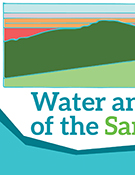Water and the Future of the San Joaquin Valley
The San Joaquin Valley—California's largest agricultural region and an important contributor to the nation's food supply—is in a time of great change. The valley is ground zero for many of California's most difficult water management problems—including groundwater overdraft, drinking water contamination, and declines in habitat and native species.
Local water supplies are limited, particularly in the southern half of the region. To irrigate their crops, many farmers use water imported from the Sacramento–San Joaquin Delta. But in many places farmers have also relied on groundwater overdraft—pumping groundwater in excess of the rate at which it is replenished. Worsening droughts, increasing regulations to protect endangered native fishes, and growing demand by Southern California for Delta imports have compounded surface water scarcity.
The state's Sustainable Groundwater Management Act (SGMA) requires local water users to bring groundwater use to sustainable levels by the early 2040s. This will have a broad impact on valley agriculture and the regional economy in coming years—likely including some permanent idling of farmland. This discussion explores three key challenges facing the San Joaquin Valley and reviews the most promising approaches to address them:
- Balancing water supplies and demands. To close the groundwater deficit, groundwater sustainability agencies in the valley's overdrafted basins will have to augment supplies, reduce demands, or use some combination of these two approaches. A range of options are under consideration but they are not equally effective or practical.
- Addressing groundwater quality challenges. Poor groundwater quality impairs drinking water supplies in disadvantaged rural communities, reduces long-term agricultural prosperity, and degrades ecosystems. Providing safe drinking water is an urgent priority. Over the longer term, parties will also need to manage water quantity and quality together, to take advantage of synergies and avoid unintended consequences. The necessary coordination will be challenging because the various programs addressing valley water quality issues are carried out by numerous local and regional entities, whose lines of responsibility and geographic boundaries do not neatly align.
- Fostering beneficial water and land use transitions. Effectively addressing water scarcity and the resulting land use changes in the San Joaquin Valley offers opportunities to put lands coming out of production to good use—and gain “more pop per drop” from limited water resources. Multiple-benefit approaches to water and land management can enhance groundwater recharge and improve air and water quality. They can also promote healthier soils, new recreational opportunities, additional flood protection, improved habitat, and new revenue streams for private landowners engaging in conservation-oriented management.
Addressing these complex and intertwined issues requires significant changes in water and land management and a major ramp-up in cooperation and coordination among a wide circle of stakeholders. Pursuing solutions that deliver multiple benefits will boost the chances of success overall. The entire region—and California as a whole—will benefit if solutions to these challenges are cost-effective and support the valley's economy while improving public health and the natural environment.
Topic: Water and the Future of the San Joaquin Valley
Speakers: Alvar Escriva-Bou,
Research Fellow, Water Policy Center, Public Policy Institute of California
When: Friday, September 27, 2019, 12 p.m.–1 p.m.
Where: The University Union, Green and Gold Room (3201), 3rd floor
Map | Register on Eventbrite
About the Speaker
 Alvar Escriva-Bou is a research fellow at the PPIC Water Policy Center. His research explores integrated water, energy, and environmental resources management, including systems approaches, simulation and optimization of economic-engineering models, and climate change analysis. Previously, he worked as a civil engineer, managing and developing large infrastructure projects for local and regional governments and consulting firms in Spain. He holds a PhD and MS in water and environmental engineering and a BS in civil engineering from the Polytechnic University of Valencia in Spain, as well as an MS in agricultural and resource economics from the University of California, Davis.
Alvar Escriva-Bou is a research fellow at the PPIC Water Policy Center. His research explores integrated water, energy, and environmental resources management, including systems approaches, simulation and optimization of economic-engineering models, and climate change analysis. Previously, he worked as a civil engineer, managing and developing large infrastructure projects for local and regional governments and consulting firms in Spain. He holds a PhD and MS in water and environmental engineering and a BS in civil engineering from the Polytechnic University of Valencia in Spain, as well as an MS in agricultural and resource economics from the University of California, Davis.

